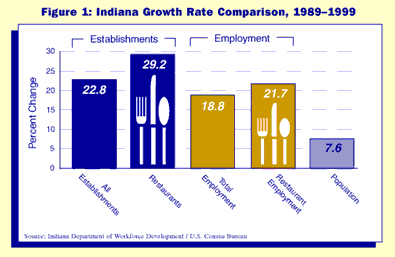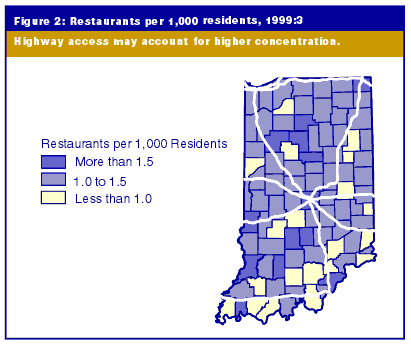Win-Win: Hoosiers Eat Out, Create Jobs
Workplace establishments identified as "eating places" are Indiana's largest employer, according to tabulations performed at the finest possible level of detail on data collected quarterly by the Indiana Department of Workforce Development. The eating places classification covers restaurants and other establishments preparing and selling food and drinks for immediate consumption. The category also includes caterers and institutional food service providers. The generic term "restaurants" will be used here to refer to the entire classification.
Employment in the restaurant industry was reported as 192,425 as of 1999's third quarter, far ahead of the second-place industry, elementary and secondary schools. Ten years earlier, the employment standings were identical, but the restaurant industry has stretched its lead considerably. From third quarter 1989 to third quarter 1999, employment in restaurants increased by 34,000, while employment in elementary and secondary schools fell by 500.
A future Indiana workforce dominated by foodservice workers may have been a fear in the early 1990s when the numbers of restaurants and their workers were increasing at a fast pace. Between '91 and '95, restaurant establishments and employment both were growing at an average annual rate of around 4% for the four-year period. However, this expansion cooled from 1995 through 1999, with the average annual growth rate dropping to less than 1% for both establishments and employment.
Figure 1 compares Indiana's growth rates for the restaurant industry and all industries, in number of establishments and employment, from 1989 to 1999. The state's 10-year population growth rate is also presented as an additional benchmark. The total number of establishments in all industries increased 22.8%, three times faster than the state's population growth of 7.6%. Employment in all industries increased by 18.8%. Growth in restaurant establishments (29.2%) and employment (21.7%) was even more dramatic.

The map in Figure 2 presents information at the county level on the number of restaurants per 1,000 residents. This kind of per capita measure allows a comparison of restaurant concentration across counties, regardless of population size.
Click on map to see larger version with county and highway labels.

Marion County, as expected, led the state in number of restaurants in 1999, but ranked fourth in restaurants per capita, behind White, Steuben and Martin counties. Each of these top three counties ranks in the bottom half of Hoosier counties on population size. Why the heavy concentration of restaurants in these comparatively small counties? One reason is that the presence of tourist or cultural attractions may pull in the dinner crowd from outlying counties. The location of interchanges along key highways could be another factor leading to a high concentration of restaurants relative to resident population. White County, for instance, is home to Lake Shafer and Indiana Beach, and is bisected by I-65.
Steuben County straddles two interstate highways and features numerous lakes, Amish settlements and Pokagon State Park. Although Martin County is far off the interstate highway system, restaurants there probably serve a large number of travelers because the county includes the crossroads where U.S. highways 50, 150 and 231 meet.
Regardless of highways and attractions, studies suggest that the sit-down family dinner, prepared and served at home, may be an endangered species. We like to have someone else feed us, and growing numbers of restaurants are cropping up to meet the demand
